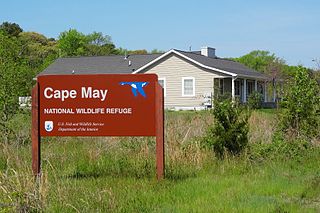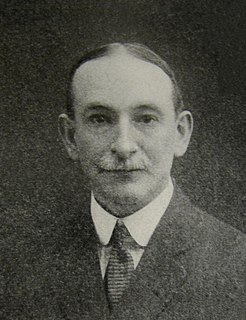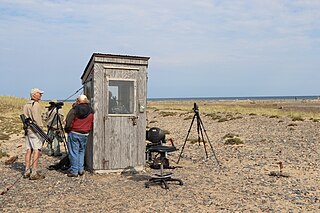
Birdwatching, or birding, is the observing of birds, either as a recreational activity or as a form of citizen science. A birdwatcher may observe by using their naked eye, by using a visual enhancement device like binoculars or a telescope, by listening for bird sounds, or by watching public webcams.

The National Audubon Society is an American non-profit environmental organization dedicated to conservation of birds and their habitats. Located in the United States and incorporated in 1905, Audubon is one of the oldest of such organizations in the world. There are completely independent Audubon Societies in the United States, which were founded several years earlier such as the Massachusetts Audubon Society and Connecticut Audubon Society.

Brewer's blackbird is a medium-sized New World blackbird. It is named after the ornithologist Thomas Mayo Brewer.

Cape May consists of a peninsula and barrier island system in the U.S. state of New Jersey. It is roughly coterminous with Cape May County and runs southwards from the New Jersey mainland, separating Delaware Bay from the Atlantic Ocean. The southernmost point in New Jersey lies on the cape. A number of resort communities line the Atlantic side of the cape, including Ocean City, the most populous community on the cape, The Wildwoods, known for its architecturally significant hotel district, and the city of Cape May, which has served as a resort community since the mid-1700s, making it the oldest such resort in the U.S.

A bird observatory is a centre for the study of bird migration and bird populations. They are usually focused on local birds, but may also include interest in far-flung areas. Most bird observatories are small operations with a limited staff, many volunteers and a not-for-profit educational status. Many bird observatories conduct bird ringing or bird banding.

David Allen Sibley is an American ornithologist. He is the author and illustrator of The Sibley Guide to Birds, which rivals Roger Tory Peterson's as the most comprehensive guides for North American ornithological field identification.

Ludlow Griscom was an American ornithologist known as a pioneer in field ornithology. His emphasis on the identification of free-flying birds by field marks became widely adopted by professionals and amateurs. Many called him "Dean of the Birdwatchers."

The Cape May National Wildlife Refuge is a protected area on the Cape May Peninsula in Cape May County, New Jersey. It is part of the National Wildlife Refuge System and managed by the United States Fish and Wildlife Service. Established in January 1989 with 90 acres (0.36 km2) acquired from the Nature Conservancy, it has since grown to more than 11,000 acres (45 km2) in size, and plans call for its further expansion to more than 21,200 acres (86 km2). It comprises three distinct and non-contiguous units: the Delaware Bay Division, the Great Cedar Swamp Division and the Two Mile Beach Unit. Located in the Middle Atlantic coastal forests ecoregion, the cape provides habitat for large numbers of migratory birds.

Frank Bennington Gill is an American ornithologist with worldwide research interests and birding experience. He is perhaps best known as the author of the textbook Ornithology, the leading textbook in the field.

Witmer Stone was an American ornithologist, botanist, and mammalogist, and was considered one of the last of the “great naturalists.” Stone is remembered principally as an ornithologist. He was president of the American Ornithologists’ Union (AOU) 1920–23, and was editor of the AOU's periodical The Auk 1912–1936. He spearheaded the production of the 4th edition of the AOU checklist, published in 1931. He worked for over 50 years in the Ornithology Department at the Academy of Natural Sciences of Philadelphia, eventually serving as Director of the institution. Stone was one of the founding members of the Delaware Valley Ornithological Club (DVOC) in 1890 and was actively involved in the organization for the remainder of his life. Stone was one of only two scientists to serve as president of both the AOU and the American Society of Mammalogists, and he co-authored two popular books about mammals. His outstanding botanical contribution was The Plants of Southern New Jersey, published in 1911. Stone spent many summers at Cape May, New Jersey, summering there annually starting in 1916. He is best remembered for his two-volume classic Bird Studies at Old Cape May, which was published by the DVOC in 1937, two years before his death.
The World Series of Birding is perhaps the world's most famous birding competition. Participants try to identify the greatest number of bird species throughout the state of New Jersey, United States, over a 24-hour period on a Saturday in mid-May. The event is also run as a fundraiser for bird conservation, with participants soliciting pledges for each species they identify. The event is organized by the New Jersey Audubon Society.
The New Jersey Audubon is an environmental education and conservation advocacy organization. Founded in 1897, it is one of New Jersey's largest environmental organizations, with 10 staffed nature centers, 34 nature preserves, and thousands of members throughout New Jersey and the world. It is an independent organization and is not affiliated with the National Audubon Society.

Pete Dunne is an American author, famous for his writings on natural history and birding. He is also the founder of the World Series of Birding, as well as the former director of the Cape May Bird Observatory, Birding Ambassador for the New Jersey Audubon Society, and former publisher of New Jersey Audubon magazine. His articles have appeared in most major American birding publications, including Birder's World, Birding, Bird Watcher's Digest, and WildBird, as well as in The New York Times. In 2001, he received the Roger Tory Peterson Award from the American Birding Association for lifetime achievement in promoting the cause of birding.
The Dungeness National Wildlife Refuge is located near the town of Sequim in Clallam County in the U.S. state of Washington, on the Strait of Juan de Fuca. The refuge is composed of 772.52 acres (312.63 ha) which include Dungeness Spit, Graveyard Spit, and portions of Dungeness Bay and Harbor. Dungeness Spit is one of the world's longest natural sand spits, 6.8 miles (10.9 km) long and very narrow. A lighthouse, the New Dungeness Light, built in 1857, is located near the end of the spit. Access to Dungeness Spit is through a Clallam County Park which has hiking trails, picnic areas, and a campground. On January 20, 1915, it was designated as a National Wildlife Refuge by President Woodrow Wilson. Dungeness is one of six refuges in the Washington Maritime National Wildlife Refuge Complex.

The Whitefish Point Bird Observatory (WPBO) is located in Chippewa County, Michigan, USA, adjacent to the Whitefish Point Unit of the Seney National Wildlife Refuge. It operates as a non-profit, affiliate education and research facility of the Michigan Audubon Society. The Society and the WPBO together have recorded over 300 species of birds at Whitefish Point. As one of a network of bird observatories in the Canadian Migration Monitoring Network, the WPBO documents the bird population of the Great Lakes region through bird banding, data collection, and research studies.

The Connecticut Audubon Society, founded in 1898 and headquartered in Fairfield, Connecticut, is a nonprofit organization dedicated to "conserving Connecticut’s environment through science-based education and advocacy focused on the state’s bird populations and habitats." Connecticut Audubon Society is independent of the National Audubon Society (NAS), just as in the neighboring state of Massachusetts, where Massachusetts Audubon Society is independent of the NAS.

Chandler Seymour Robbins was an American ornithologist. His contributions to the field include co-authorship of an influential field guide to birds, as well as organizing the North American Breeding Bird Survey.

Hawkwatching is a mainly citizen science activity where experienced volunteers count migratory raptors in an effort to survey migratory numbers. Groups of hawkwatchers often congregate along well-known migratory routes such as mountain ridges, coastlines and land bridges, where raptors ride on updrafts created by the topography. Hawkwatches are often formally or informally organized by non-profit organizations such as an Audubon chapter, state park, wildlife refuge or other important birding area. Some hawkwatches remain independent of any organizing structure.

Higbee Beach Wildlife Management Area is a 1,159-acre (469 ha) wildlife management area in Lower Township, Cape May County, New Jersey.















